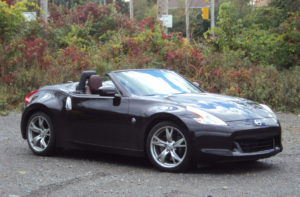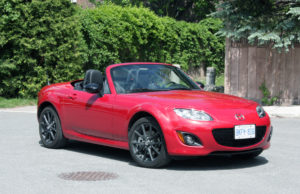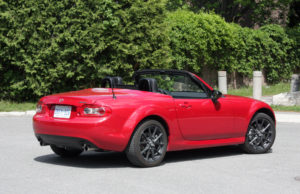Forget Christmas: Spring is the most wonderful time of the year when we relish the opportunity to drive with the windows — or, even better, the top — down. We thought we’d celebrate April’s milder weather and longer days by looking at a selection of used convertibles.
Cars with folding tops make up just a small slice of the marketplace. Still, there is enough selection to make it hard to cover the full segment in one article. Therefore, this month’s piece focuses on a quartet of well-known models. These cars are all quite different: one is a modest four-cylinder, while two offer powerful V8s; two are roadsters and the others seat four. All of these cars do share a few common traits: they’re fun rear-wheel drive models that are affordable to buy used.
Chevrolet Camaro, 2011-2015
Chevrolet revived the Camaro coupe in 2010 following a long hiatus, and a convertible version arrived in 2011.
- Initial engine choices were a 3.6L V6 (312 hp) and two versions of a 6.2L V8 making 400 and 426 hp.
- Chevrolet upgraded the V6 to 323 hp in 2012, and added a ZL1 trim with a 580-hp supercharged V8.
- The Camaro was offered with six-speed manual and automatic transmissions.

Naturally, the V8 engines are the performance champs of the Camaro range. They’re also more reliable than the V6. That entry-level engine is known for problems with worn timing chains and oil consumption. The direct fuel-injection system promotes power and economy, but it also allows gunk to build up on the intake valves, which can affect performance and is expensive to remedy.

When test-driving, check that the key releases from the ignition after you turn the car off. This is probably due to a fault in the automatic transmission’s shift interlock system. It’s designed to prevent the key from being removed when the shifter is not in park and the car could roll away.
After shutting the car off, wait a couple of minutes and then restart it. Some owners say their Camaro engines hesitate or stall when restarted hot, but no one seems to know why.
Other worthwhile checks include the air conditioning and touchscreen systems. If the infotainment screen responds slowly or crashes, the car might need a software update (cheap) or new hardware (expensive). If the A/C doesn’t blow the temperature of air you command from the vents you select, you have to remove the dash to replace faulty parts.
Ford Mustang, 2005-2014
The Ford Mustang adopted retro styling in 2005, and subsequent generations have evolved that look.
- Up to 2010, the base engine was a 210-hp V6, while two V8s made 315 hp and 540 hp respectively.
- Transmissions were five- and six-speed manuals and a five-speed automatic.
- Starting in 2011, a new V6 made 305 hp, and Ford brought back its well-known 5.0L V8 with 412 hp.
- In this generation’s later years, Ford rolled out a GT500 with 662 hp.
Older V6 cars have a plastic engine-thermostat housing that can crack and leak coolant. Hesitation on acceleration at highway speeds in V6 and V8 cars is caused by air bubbles forming around the fuel pump. In the same early cars, water can get into the parking-brake cable assembly and freeze, which prevents the parking brake from releasing.

Some owners of later Mustang models with SYNC infotainment complain the system often crashes. In some cases, the only permanent fix is to replace the hardware behind the touchscreen.
If you test-drive a newer 5.0L car with the manual transmission, make sure the shifter behaves. A gearbox that pops out of gear or grinds when you shift may have been abused.
Nissan 370Z, 2010-2018
Nissan has been building its Z sports car for nearly 50 years. The original was called the 240Z; the name has changed over the years to reflect larger, more powerful engines. The latest version is the 370Z, introduced in 2009; Nissan added a convertible version in 2010.
- The engine is a 3.7L V6 that makes 332 hp.
- A six-speed manual transmission is standard.
- A seven-speed automatic is the option.

Owners have few complaints about the 370Z’s durability. Convertible models are less likely to have seen winter driving than the coupe variant, but be on the lookout for rust. Check the bottoms of the doors, taking a peek behind the weather stripping. While you’re crawling around, inspect the rocker panels (that’s the part of the body below the doors) and try to get a look at the underbody. Look for paint damage, too, especially on the front of the body.
Manual transmission models with an optional sport package are designed to automatically rev the engine as you shift to a lower gear. Check whether it works properly. You can disable this feature if you don’t like it; you might appreciate the sport package’s bigger brakes and wheels more.
Mazda MX-5, 2006-2015
Mazda introduced the third-generation MX-5 Miata in 2006.
- It used a four-cylinder engine that made a modest 170 hp and came standard with five- and six-speed manual transmissions, depending on the trim level.
- The option was a six-speed automatic, which came with a slightly less-powerful version of the same engine.
- In 2007, Mazda added an optional power retractable hard top called PRHT for short.

If you notice the manual transmission is difficult to shift, it could be due to a lack of lubrication in the linkage between the shifter and transmission. It may also indicate a clutch pedal that needs an adjustment.

Some owners have had to replace suspension shock absorbers prematurely. This was a common Mazda flaw in the mid-2000s.
If the engine takes a long time to warm up (which can be hard to detect in warm weather) the thermostat has probably failed. This simple device is designed to stay open when it fails; if it failed in the closed position, the engine would overheat.
Check the trunk for dampness. The Miata has a “rain rail” designed to guide water to a space between the convertible roof and the car’s body, where there are drain holes. If that rail is cracked, water can get into the trunk. Drain holes blocked with leaves and other debris can also cause water leaks.
What else should you watch for in a used convertible?
- The roof: Among the top checks you should make is that the roof doesn’t leak. Drive through a high-pressure car wash. A few drops of water or two from around the windows is okay; we’ve driven new versions of some of these cars that leaked a little. Anything more could indicate a tear in the roof fabric. Also, feel the carpet. If it’s damp, that could be proof of past leaks.
- Roof mechanisms: Of the cars listed here, only the Mazda MX-5 came standard with a manually operated roof. Electric roof mechanisms are complicated and expensive to replace. Operate the roof several times during your test drive to make sure it goes up and down smoothly. If you notice any hesitation or hitches in its movement, you could be looking at a pricey future repair.
- Pre-purchase inspection: Because these are performance cars, many examples will have been driven enthusiastically, including at racetracks. That in itself is not a big deal, but a pre-purchase inspection by a mechanic is a good idea. A trained technician can pick out signs of abuse, like unevenly worn tires, and evidence of neglected maintenance. Frequent hard acceleration shortens the life of a clutch and other transmission parts.
- Modified parts: Finally, avoid cars that have been modified with aftermarket performance parts. Their presence makes it more likely the car has been driven hard. Some additions push the engine to its limits and can affect its longevity. There are also a lot of cheap aftermarket parts that simply don’t last and can make an otherwise good car unreliable.


